Mike Trout over Ken Griffey Jr? Not yet
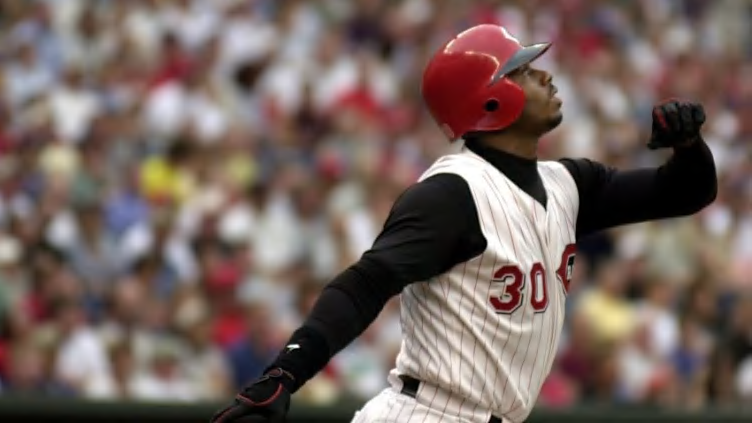
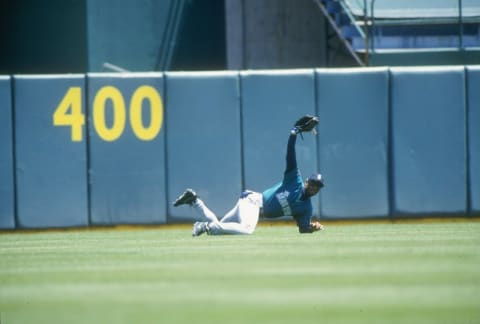
The experts say Angels star Mike Trout has surpassed Ken Griffey Jr. as the best centerfielder of the divisional era. Not yet
Has Mike Trout already done enough to surpass Ken Griffey Jr. as the best center fielder of the divisional era?
MLB Network personalities Brian Kenny and Bob Costas say he has. Both selected Trout ahead of Griffey when the third installment of the network’s ‘Top 10 Right Now’ focused on post-1969 center fielders Wednesday night.
Keep in mind that in Griffey, we’re talking about a first-ballot Hall of Famer who was named on 99.3 percent of the ballots. We’re talking about a player who to date has more than twice as many home runs as Trout, more than twice as many RBIs, and who has played more than twice as many games.
Granted Trout still has half his career to be played. But even using an age 28 equivalency, Griffey appears to be the better candidate. Using that as a benchmark, Griffey still leads Trout in home runs (350 to 302), RBIs (1,018 to 798), and base hits (1,569 to 1,380). Trout does lead Griffey in career batting average through age 28 (.304 to .300) and walks (838 to 656).
For the record, here are the respective top 10s of Kenny and Costas:
Kenny Costas
1 M Trout M Trout
2 K Griffey Jr. K Griffey Jr.
3 C Beltran J Edmonds
4 B Williams K Puckett
5 J Edmonds D Murphy
6 D Murphy F Lynn
7 K Puckett An Jones
8 An Jones K Lofton
9 K Lofton C Beltran
10 F Lynn B Williams
The interesting aspect of the Kenny and Costas lists is that they settled on the identical 10 players, albeit in some different order. But their decision to place Trout ahead of Griffey is, as the data below shows, at best problematic. In fact, it’s not at all clear that Trout has already done enough to even nail down the No. 2 slot on a post-1969 list.
He probably will eventually…but not yet.
To actually assess who deserves to be on this list, in what order, and how good a job either Kenny or Costas did, we need some criteria. Probably due to time constraints, neither Kenny nor Costas specified their criteria, although in the case of Kenny and probably Costas as well you can assume they had some.
We’re going to apply four criteria designed to reflect the broad spectrum of demands placed on center fielders. We’ve assessed 30 well-known men who played more games at center field than any other position and given them an ordinal score equal to their rank in each of the criteria.
Alphabetically, the 30 nominees are: Brady Anderson, Carlos Beltran, Brett Butler, Lorenzo Cain, Cesar Cedeno, Johnny Damon, Eric Davis, Jim Edmonds, Jacoby Ellsbury, Steve Finley, Ken Griffey Jr., Torii Hunter, Adam Jones, Andruw Jones, Matt Kemp, Chet Lemon, Kenny Lofton, Fred Lynn, Garry Maddox, Andrew McCutchen, Willie McGee, Rick Monday, Dale Murphy, Amos Otis, Kirby Puckett, Mike Trout, Andy Van Slyke, Vernon Wells, Bernie Williams, and Willie Wilson.
When all four categories are assessed, the player with the average ordinal score closest to a perfect rating of 1.0 is the winner.
The criteria are: 1. five-year peak performance with OPS+ as the yardstick; 2. accumulated career OPS+; 3. All Star game appearances, Gold Glove and Silver Slugger awards; 4. Career Defensive Wins Above Average.
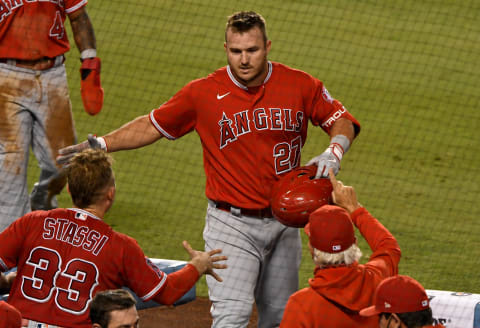
Five-year peak performance
This criteria is simply the player’s best five-season average OPS+. Here are the 10 best among the 30 candidates.
Rank Center fielder Seasons Average
1 Mike Trout 2015-2019 183.0
2 Jim Edmonds 2000-2004 157.0
3 Ken Griffey Jr. 1993-1997 156.6
4 Andrew McCutchen 2011-2015 151.8
5 Bernie Williams 1997-2001 147.0
6 Dale Murphy 1983-1987 145.6
7 Cesar Cedeno 1972-1976 142.8
8 Eric Davis 1986-1990 142.6
9 Fred Lynn 1975-1979 140.4
10 Chet Lemon 1978-1982 138.6
If any category would favor a still-in-his-prime player like Mike Trout over those who had completed full-career resumes, it would be this peak-based one. And indeed Trout comes out ahead, beating the two logical closest competitors, Edmonds and Griffey.
His 183.0 average is astonishingly high for a five-season period, but not surprising to anybody who has watched him. Trout produced a 198 OPS+ — essentially doubling the performance value of an average player – in 2018 and was above 180 in both 2017 and 2019.
As the data suggests, the difference between Edmonds and Griffey was microscopic. At their respective peaks, both topped out at a 171 OPS+, Griffey doing so in both 1993 and 1994. But Griffey had – by his standards – an off season in 1995 when he missed half the season due to injury. That dropped his OPS+ to 122.
Edmonds had no such anomalous season to drag down his score…in fact, during his peak seasons, his low OPS+ was 147. That is solidly at an All-Star level.
Possibly the big surprise in this category was Chet Lemon, often overlooked today but a solid performer with the late 1970s and mid 1980s White Sox and Tigers. Between 1978 and 1982, Lemon produced five seasons above a 120 OPS+, peaking at 155 in 1981.
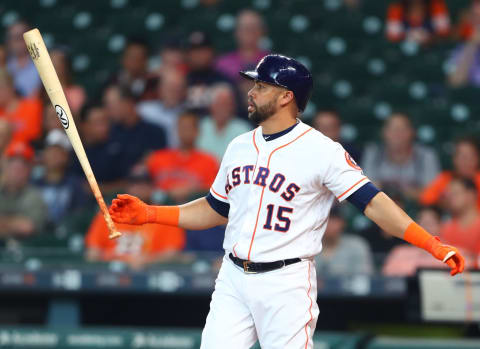
Cumulative career OPS+
This category, which is simply the sum of each center fielder’s OPS+ values over the course of his career, is designed to reward longevity. It is essentially a counter-balance to the first, peak-performance oriented, category.
In that respect it is different from career OPS+ because it emphasizes duration of performance.
And this is where Trout’s vulnerability comes into play. As brilliant a career as he has had to date, with 1,688 cumulative career OPS+ points he stands only 18th among the 30 candidates – that’s lower half. Griffey, who heads up the cumulative career list, is more than 1,000 career OPS points ahead of Trout.
Given a decade of his usual performance, it is entirely possible that Trout erases that gap. But he hasn’t done it yet.
Here’s the top 10.
Rank Player Cumulative Career OPS+
1 Ken Griffey Jr. 2,839
2 Carlos Beltran 2,354
3 Rick Monday 2,236
4 Cesar Cedeno 2,009
5 Fred Lynn 1,991
6 Eric Davis 1,972
7 Bernie Williams 1,957
8 Jim Edmonds 1,948
9 Steve Finley 1,872
10 Torii Hunter 1,853
Griffey’s lead in this category should be no surprise, but Beltran, Monday, and Cedeno make the big statements here. This is especially important for Monday and Cedeno, neither of whom made either the Kenny or Costas lists. Their cumulative OPS+ makes it clear that they at least need to get strong consideration.
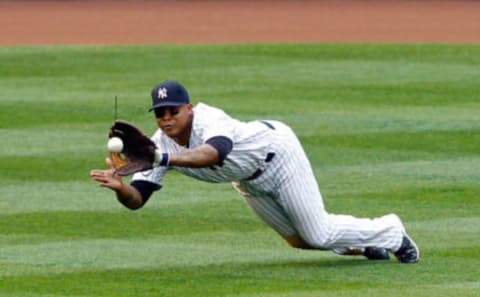
Awards
Peer and contemporary recognition is one important tool for measuring a player’s skill. This category is designed to factor that into the overall evaluation. As with the previously published rating for catchers, the components are a combination of All Star game selections and Gold Glove awards. But in a nod to the importance to center fielders of offense, Silver Slugger Awards have also been added.
Here’s the ranking of the most frequent honorees
Rank Center fielder Awards
1 Ken Griffey Jr. 30
2 Kirby Puckett 22
3 Mike Trout 16
3 Torii Hunter 16
3 Andruw Jones 16
3 Dale Murphy 16
7 Carlos Beltran 14
8 Fred Lynn 13
8 Jim Edmonds 13
10 Bernie Williams 10
10 Kenny Lofton 10
10 Andrew McCutchen 10
10 Andy Van Slyke 10
10 Adam Jones 10
To some extent, Griffey’s edge in this category is also due to his comparative longevity, at least measured against Trout. But not all or even most of it. Through his age 28 season, Griffey had already accumulated 22 Gold Gloves, Silver Sluggers, and All Star Game selections. That’s still six more than Trout has gathered to date.
It does, however, provide Trout with room to catch up over the next few seasons. After age 28, Griffey won just one more Gold Glove, one more Silver Slugger, and made only four more All Star Game appearances.
The candidacies of Murphy, Hunter and Andruw Jones get a big boost in this measuring tool as well. Murphy’s 16 includes seven All Star Game appearances, five Gold Gloves, and four Silver Sluggers. Hunter was a five-time All Star with nine Gold Gloves and two Silver Sluggers, and Jones added 10 Gold Gloves plus one Silver Slugger to his five All Star Game appearances.
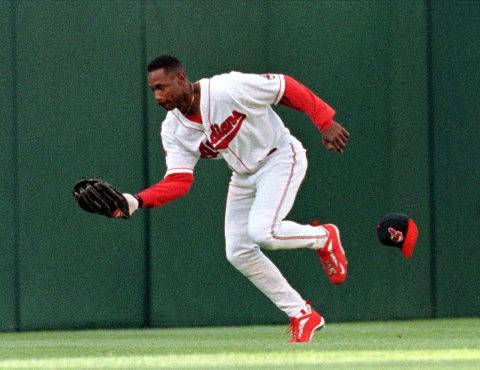
Defensive War
Center field is both an offensive and defensive position. While Defensive Runs Saved is an excellent tool for measuring the defensive contributions of players, data for that criteria does not exist for pre-2003 competitors.
That makes career Defensive War the appropriate fallback defensive stat to assess the contributions of players across the past half century. The number reflects the number of runs a player is projected to have saved his team due to his defensive play.
Here are the top 10 for center fielders since 1969.
Rank Center fielder Career DWar
1 Andruw Jones 24.4
2 Kenny Lofton 15.5
2 Lorenzo Cain 15.5
4 Garry Maddox 11.4
5 Willie Wilson 10.7
6 Chet Lemon 9.0
7 Jim Edmonds 6.4
8 Jacoby Ellsbury 6.0
9 Torii Hunter 4.0
10 Steve Finley 3.5
Career Defensive War turns out to be a tripwire stat for both the leading candidates. At 2.7 Defensive WAR, Trout ranks 12th, behind the top 10 and Andy Van Slyke (2.9). Griffey’s defensive rating belies his reputation as an exceptional defensive center fielder. His career score of 2.2 ranks 13th, one spot behind Trout.
Instead, the category is dominated by guys who are trying to solidify spots somewhere among the top 10. Jones, on this year’s Hall of Fame ballot, heads the list. Between his first full season, 1997, and 2002, Jones never fell below 2.3 Defensive WAR, meaning his defense alone was worth more than two games per year to the Braves annually in comparison with a replacement player.
The inclusion of Edmonds in the seventh spot, five places ahead of Trout, will be significant in the overall evaluation.
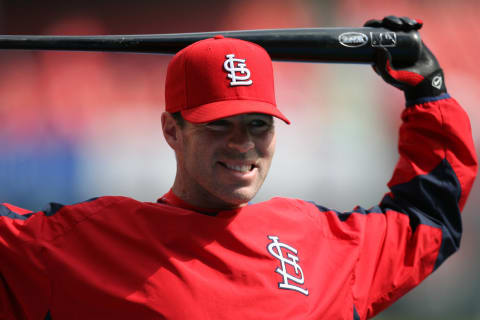
The final tabulation
The tabulation below is based on the average ordinal placement of each of the 30 center fielders in all four categories. A score of 1.0, indicating a first place rank in all four categories, would be perfect. The list also shows the center fielder’s standing on the Kenny and Costas lists.
Rank Center fielder Ordinal Avg Kenny Costas
1 Ken Griffey Jr. 4.50 2 2
2 Jim Edmonds 6.25 5 3
3 Mike Trout 8.50 1 1
4 Andruw Jones 9.00 8 7
5 Carlos Beltran 9.50 3 9
6 Torii Hunter 10.50 NR NR
7 Fred Lynn 11.00 10 6
8 Kenny Lofton 12.75 9 8
8 Cesar Cedeno 12.75 NR NR
10 Chet Lemon 13.00 NR NR
Griffey beat Trout because he led in two categories – cumulative career OPS+ and awards – that favor performance over time. But how does Edmonds also rank ahead of the Angels great.
The answer gets back to career accumulation. Trout did lead the field in peak OPS+, but Trout finished right behind him in second. In career OPS+, Edmonds finished eighth overall, 10 places ahead of Trout.
Trout did beat Edmonds by five positions in total awards, but Edmonds offset that with a five-placement advantage in Defensive WAR.
Based on the Kenny and Costas ratings, Hunter’s sixth place finish may be the other big surprise. He made neither expert’s top 10. His 16 career awards – good or a tie for third – helped him.
The bottom of this top list is tight, so the fact that Costas and Kenny chose Williams, Murphy and Puckett over Cedeno and Lemon is not much to fight about. In this ranking, the eighth through 13th finishers averaged as follows:
8 Lofton 12.75
9 Cedeno 12.75
10 Lemon 13.00
11 Williams 13.50
12 Murphy 13.75
13 Puckett 14.00
Kenny said he elevated Williams in part due to his post-season excellence. That’s fair. Murphy took a fatal hit for Defensive War, a category in which at -6.8 he ranked 29th among the 30 candidates. Absent that, he might have ranked as high as third or fourth.
Puckett’s candidacy was undermined by his 1,487 cumulative OPS+, a byproduct of the ailments that prompted a premature retirement at age 35. That OPS+ ranked only 26th. His average in the other three categories was 10.0.
The bottom line: Kenny and Costas got this one wrong. They probably elevated Trout ahead of Griffey on the basis of what they expect him to do rather than what he has already done. That or recency bias came into play.
Next. The best catcher of the divisional era. dark
At some future date, Mike Trout might deserve to be called the best center fielder of the divisional era. That day has not yet arrived.